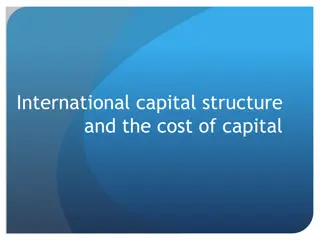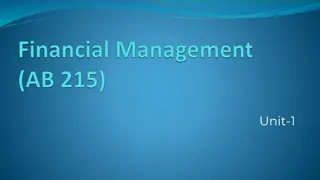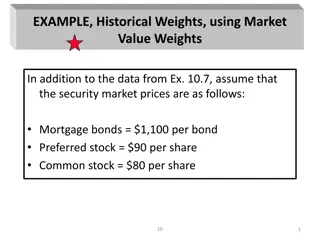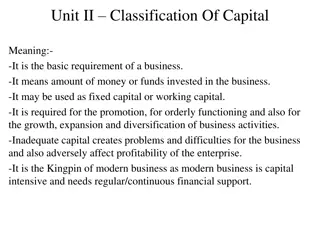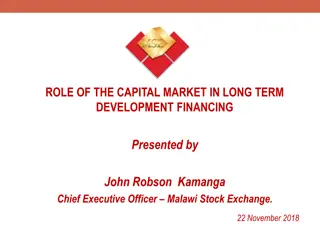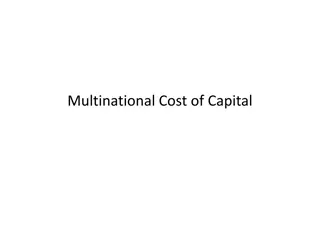Understanding the Cost of Capital in Finance
The cost of capital is crucial for businesses to determine the average cost of their finance. The Weighted Average Cost of Capital (WACC) is used as a discount rate in financial calculations. It involves estimating the cost of each source of finance and calculating a weighted average. Additionally, the cost of equity and debt are key components in this calculation, with methods such as the Dividend Valuation Model (DVM) and profit retention-based approaches used for estimating growth. Debt features such as tax deductibility and interest payments are discussed, along with formulas to calculate the cost of debt for various scenarios.
Download Presentation

Please find below an Image/Link to download the presentation.
The content on the website is provided AS IS for your information and personal use only. It may not be sold, licensed, or shared on other websites without obtaining consent from the author. Download presentation by click this link. If you encounter any issues during the download, it is possible that the publisher has removed the file from their server.
E N D
Presentation Transcript
Chapter 2 Cost of Capital IMAS 1
Cost of capital The weighted average cost of capital (WACC) measures the ave rage cost of an entity's finance. Entities often use the WACC as a disc ount rate in net present value (NPV) calculations Deriving the WACC 1. Estimating the cost of each source of finance 2. Calculating a weighted average step 1 IMAS 2
Cost of Equity The cost of equity is the rate of return that ordinary shareholders expec t to receive on their investment For our syllabus we use the Dividend valuation model to calculate cost of equity. Po = d ke ke - cost of equity Po - the ex div market price of the share d - constant dividend IMAS 3
DVM with growth Ke = do ( 1+ g) + g Po g - constant rate of growth in dividends do - current dividend d1 - dividend to be paid in one year s time IMAS 4
Estimating growth Averaging method The growth model based upon profit retention IMAS 5
Cost of debt The cost of debt is the rate of return that debt providers require on the funds that they p rovide. **The value of debt is assumed to be the present value of its future cash flows Features of debt Debt is tax deductible and hence interest payments are made net of tax. Debt is always quoted in $100 nominal units or blocks. Interest paid on the debt is stated as a percentage of nominal value. This is known as the coupon rate. It is not the same as the cost of debt. The amount of interest payable on the debt is fixed. The interest is calculated as the coupon rate mult iplied by the nominal value of the debt. Debt is normally redeemable at par (nominal value) or at a premium or discount. Interest can be either fixed or floating (variable) on borrowings, but bonds normally pay fixed rate interest. IMAS 6
Cost of debt for bank borrowing Kd = r ( 1 T) r annual interest rate in percentage terms T corporate tax rate IMAS 7
Cost of irredeemable debt Kd = i ( 1 T) PO i interest paid each year P ex interest market price of the bonds, normally quoted per 100 unit nominal IMAS 8
Cost of debt for redeemable bonds The Kd for redeemable bonds is given by the IRR of the relevant cash flows Year Cash flow 0 Market value of the bond 1 to n Annual interest payments net of tax i(1 - T) n Redemption value of the bond *** Interest payments should be included net of tax IMAS 9
WACC The weighted average cost of capital (WACC) is the average cost of the entity's finance (equity, bonds, bank loans, and preference shares)weig hted according to the proportion each element bears to the total p ool of funds. Calculate weights for each source of capital. Estimate the cost of each source of capital. Multiply the proportion of the total (Market value) of each source of capital by the cost of that source of capital. Sum the results of step 3 to give the weighted average cost of c apital IMAS 10
When to use WACC The WACC is often used as a discount rate when using net present value or i nternal rate of return calculations. However, this is only appropriat e if the following conditions are met: The capital structure is constant. If the capital structure changes, the weigh tings in the WACC will also change. The new investment does not carry a different business risk profile to t he existing entity's operations. The new investment is marginal to the entity. If we are only looking at a s mall investment then we would not expect any of ke, kd or the WA CC to change materially. If the investment is substantial it will usually caus e these values to change IMAS 11
Yield on debt Yield on irredeemable debt YTM = (annual interest received) current market value of debt * 100 Yield on redeemable debt YTM = the final redemption amount IRR of the bond price, the annual interest received and IMAS 12
Yield on redeemable debt IRR ~ L + NPVL (H L) NPVL - NPVH L lower discount rate H Higher discount rate NPVL - NPV at lower discount rate NPVH - NPV at higher discount rate IMAS 13
Section B Financial Reporting 60% IMAS 14







